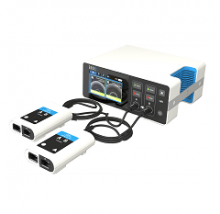The US Food and Drug Administration (FDA) has granted 510(k) clearance for the EKOS® Control Unit 4.0, a new unit that can control the EKOS® System.
The EKOS System includes an ultrasonic device that uses acoustic pulses to enhance the effects of thrombolytic drugs and dissolve blood clots in patients with deep vein thrombosis, pulmonary embolism, and peripheral arterial occlusions.
With this system, acoustic pulses unwind and thin fibrin to expose drug receptor sites.
This allows thrombolytic drugs to reach deeper into clots, accelerating absorption and helping to dissolve clots faster and with less drug, according to BTG International LTD, the company that markets the EKOS System.
The EKOS Control Unit 4.0 replaces the EKOS System’s old control unit. The new unit can support 2 EKOS devices, allowing physicians to use a single control unit to treat both pulmonary arteries, with the goal of simplifying bilateral pulmonary embolism treatment.
The EKOS System (formerly known as the EkoSonic Endovascular System) was approved by the FDA in 2014.
In clinical studies, the system has been shown to speed time to clot dissolution, increase clot removal, and enhance clinical improvement compared to either standard catheter-directed drug therapy or thrombectomy.1,2
Research has also shown that the EKOS System requires significantly shorter treatment times and less thrombolytic compared to standard catheter-directed drug therapy3, 4,5, lowering the risk of bleeding and other complications.1,5,6

1. Lin, P, et al, “Comparison of Percutaneous Ultrasound-Accelerated Thrombolysis versus Catheter-Directed Thrombolysis in Patients with Acute Massive Pulmonary Embolism.” Vascular, Vol. 17, Suppl. 3, 2009, S137–S147.
2. Schrijver, AM, et al, “Dutch Randomized Trial Comparing Standard Catheter-Directed Thrombolysis and Ultrasound-Accelerated Thrombolysis for Arterial Thromboembolic Infrainguinal Disease (DUET)." Journal of Endovascular Therapy 2015, Vol. 22(1):87-95.
3. Litzendorf, ME, et al, “Ultrasound-accelerated thrombolysis is superior to catheter-directed thrombolysis for the treatment of acute limb ischemia.” Journal of Vascular Surgery, Jun 2011; 53(Suppl S), p106S-107S.
4. Lin, P, et al, “Catheter-Directed Thrombectomy and Thrombolysis for Symptomatic Lower-Extremity Deep Vein Thrombosis: Review of Current Interventional Treatment Strategies.” Perspectives in Vascular Surgery and Endovascular Therapy, 2010, 22(3): 152–163.
5. Parikh, S, et al, “Ultrasound-Accelerated Thrombolysis for the Treatment of Deep Vein Thrombosis: Initial Clinical Experience.” Journal of Vascular and Interventional Radiology, Vol. 19, Issue 4, April 2008, 521–528.
6. Kucher, N, et al, “Randomized, Controlled Trial of Ultrasound-Assisted Catheter-Directed Thrombolysis for Acute Intermediate-Risk Pulmonary Embolism.” Circulation, Vol. 129, No. 4, 2014, 479–486.


